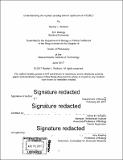Understanding the nutrient sensing branch upstream of mTORC1
Author(s)
Wolfson, Rachel L. (Rachel Laura)
DownloadFull printable version (25.02Mb)
Other Contributors
Massachusetts Institute of Technology. Department of Biology.
Advisor
David M. Sabatini.
Terms of use
Metadata
Show full item recordAbstract
mTORC1 is a master regulator of cell growth that responds to diverse environmental inputs and is deregulated in human diseases, such as cancer and epilepsy. One important input to this system is amino acids, such as leucine, which require the Rag GTPases and its regulators, including GATOR1 and GATOR2, to modulate mTORC1 activity. How amino acids, specifically leucine, are directly sensed, however, was elusive for many years. In this thesis, we first characterize the role of the Rag GTPases in follicular lymphoma. We identify recurrent, mTORC1-activating mutations in RRAGC, the gene that encodes RagC, in a large portion of follicular lymphoma samples (17%). These variants in RagC increase raptor binding and render cells partially insensitive to amino deprivation, implying that mTOR inhibitors may be effective therapies for these patients. In addition, we identify Sestrin2 as the long-sought leucine sensor for the mTORC1 pathway. Sestrin2 acts as a negative regulator of the pathway that binds GATOR2 only under leucine deprivation. We find that Sestrin2 directly binds leucine at concentrations consistent with those sensed by the pathway. Further, we find that the leucine-binding capacity of Sestrin2 is required for leucine to activate mTORC1 in cells, establishing Sestrin2 as a leucine sensor for the pathway. Finally, we identify a four-membered complex, KICSTOR (for KPTN, ITFG2, C12orf66, and SZT2-containing regulator of mTORC1), which is necessary for targeting GATOR1 to the lysosomal surface and for its interaction with its substrates, the Rag GTPases, and its potential regulator, GATOR2. Mutations in three of the components of KICSTOR are found in patients with epilepsy or brain malformation disorders, suggesting that rapalogs or other mTOR inhibitors could have some efficacy in these patients.
Description
Thesis: Ph. D., Massachusetts Institute of Technology, Department of Biology, 2017. Cataloged from PDF version of thesis. Includes bibliographical references.
Date issued
2017Department
Massachusetts Institute of Technology. Department of BiologyPublisher
Massachusetts Institute of Technology
Keywords
Biology.